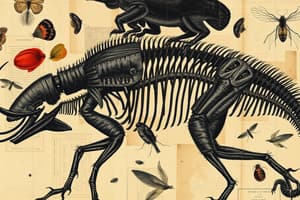Podcast
Questions and Answers
What is taxonomy?
What is taxonomy?
The branch of science which deals with classification of organisms into groups with similar characteristics.
What are the two branches of taxonomy?
What are the two branches of taxonomy?
Nomenclature and systematics.
What is nomenclature?
What is nomenclature?
The naming of organisms.
What is systematics?
What is systematics?
Who pioneered the biological nomenclature system?
Who pioneered the biological nomenclature system?
What is the binomial system?
What is the binomial system?
What are domains?
What are domains?
What are kingdoms?
What are kingdoms?
What are the characteristics of Monera?
What are the characteristics of Monera?
What are the characteristics of Protista?
What are the characteristics of Protista?
What are the characteristics of fungi?
What are the characteristics of fungi?
What are the characteristics of Plantae?
What are the characteristics of Plantae?
What are the characteristics of Animalia?
What are the characteristics of Animalia?
What are the general characteristics of the animal kingdom?
What are the general characteristics of the animal kingdom?
What phylum do humans belong to?
What phylum do humans belong to?
What is a notochord?
What is a notochord?
What are the features of the notochord?
What are the features of the notochord?
What other characteristics do Chordata have?
What other characteristics do Chordata have?
What do the pharyngeal gill slits and pouches develop into?
What do the pharyngeal gill slits and pouches develop into?
What other animals are considered part of the Chordata phylum?
What other animals are considered part of the Chordata phylum?
What does the hollow tubular nerve cord develop into?
What does the hollow tubular nerve cord develop into?
What does the post-anal tail develop into?
What does the post-anal tail develop into?
What are the general characteristics of Mammalia?
What are the general characteristics of Mammalia?
What order are humans a part of?
What order are humans a part of?
What are the characteristics of the Primata order?
What are the characteristics of the Primata order?
What family are humans a part of?
What family are humans a part of?
What are the characteristics of the Hominidae family?
What are the characteristics of the Hominidae family?
What is the binomial name for humans?
What is the binomial name for humans?
What is human taxonomy?
What is human taxonomy?
What is evolution?
What is evolution?
What is natural selection?
What is natural selection?
Flashcards are hidden until you start studying
Study Notes
Taxonomy
- Taxonomy is the science of classifying organisms based on shared characteristics.
- It encompasses two primary branches: nomenclature (naming organisms) and systematics (organizing organisms into groups).
Nomenclature & Systematics
- Nomenclature refers specifically to the naming conventions used in biology.
- Systematics involves the classification and organization of living things.
Pioneers of Taxonomy
- Carl Linnaeus is credited with developing the biological nomenclature system, creating a framework for naming species.
Binomial System
- The binomial nomenclature system assigns two Latin names to each organism: a generic name (capitalized) and a species name (italicized and lowercase).
Biological Classification Domains
- Three main domains of life exist: Eubacteria, Archaea, and Eukarya.
- These domains represent the highest level of biological categorization.
Kingdoms of Life
- Life is further divided into five kingdoms: Fungi, Monera, Protista, Plantae, and Animalia.
Characteristics of Life Forms
- Monera: Characterized by being prokaryotic, unicellular, and microscopic.
- Protista: Unicellular and microscopic with eukaryotic cells and membrane-bound organelles.
- Fungi: Eukaryotic organisms that can be unicellular (yeast) or multicellular (molds) and are saprophytic.
- Plantae: Multicellular and primarily autotrophic, utilizing photosynthesis.
- Animalia: Eukaryotic, multicellular, heterotrophic organisms that possess muscle tissue.
Animal Kingdom Overview
- General traits of the animal kingdom include being eukaryotic, multicellular, and having heterotrophic diets, muscle tissues, and nervous tissues.
Chordata Phylum
- Humans belong to the phylum Chordata, characterized by the presence of a notochord.
Notochord Features
- A notochord is a flexible supporting rod that helps in the specialization of body parts and eventually develops into the vertebral structure.
Additional Chordate Characteristics
- Key characteristics include pharyngeal gill slits, a hollow nerve cord, and a post-anal tail.
Development from Features
- Pharyngeal gill slits develop into various structures, including tonsils and glands.
- The hollow nerve cord evolves into the spinal cord and brain, positioned above the notochord.
- The post-anal tail becomes the coccyx.
Mammalia Characteristics
- Mammals possess mammary glands, fur (pili), endothermic properties, and heterodont dentition.
Primata Order
- Humans fall under the order Primata, distinguished by specific dental structures, clavicles, and stereoscopic vision.
Hominidae Family
- The family Hominidae includes species that exhibit bipedalism and a significantly developed cerebral hemisphere, allowing for complex behaviors.
Human Classification
- Binomial name for humans is Homo sapiens.
- Taxonomy levels for humans: Kingdom - Animalia, Phylum - Vertebrata (Chordata), Class - Mammalia, Order - Primates, Family - Hominidae, Genus - Homo, Species - sapiens.
Evolution & Natural Selection
- Evolution is defined as a change in the genetic composition of organisms over generations.
- Natural selection is a key mechanism in evolution, favoring traits that enhance survival and reproduction, commonly referred to as "survival of the fittest."
Studying That Suits You
Use AI to generate personalized quizzes and flashcards to suit your learning preferences.




